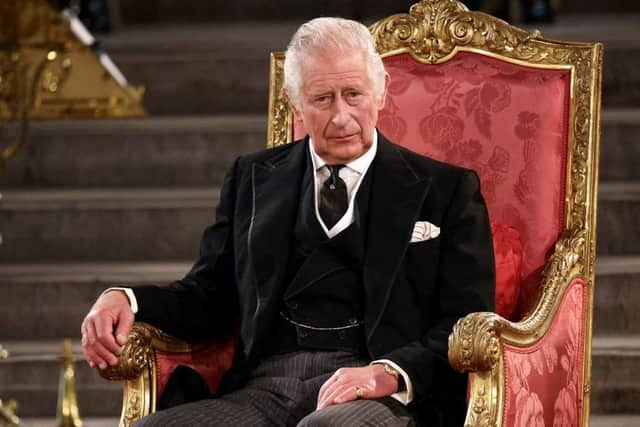If King Charles III is serious about reforming the monarchy, he should start with its finances – Martyn McLaughlin
There is scant room for nuance, but it is an occasion which ought to invite some considered scrutiny of our new king and his intentions. For all that the event is a living history designed to project the monarchy's stability and continuity, it also serves the crucial purpose of setting out a vision of its future. The coronation will provide hints of this courtesy of little concessions to modernism speckled through the symbolism of its ancient ceremony. In truth, however, the public deserves some clear answers.
It is also in the King’s interests to provide them. While a clear majority (58 per cent) of British adults polled in a recent YouGov survey expressed support for the continuation of the monarchy, nearly a third (30 per cent) said it had not gone far enough in its modernisation efforts. Significantly, 45 per cent considered Charles as being “out of touch.”
Advertisement
Hide AdAdvertisement
Hide AdQuestions around what he should do to ensure the institution he helms is fit for the 21st century seems fitting in a week marking the 30th anniversary of the late Queen’s announcement that Buckingham Palace would open its doors to the public for the first time. Within days, every group booking slot had been filled for three years.
There have been whispers and nudges that her son will follow suit. Two years ago, a series of stories indicated that Charles would grant the public greater access to the monarch’s official and private homes, transforming them from “private spaces to public places”. Last year, meanwhile, the Daily Telegraph suggested that he may “gift Balmoral to the nation” as part of a more “entrepreneurial” approach to royal bricks and mortar.
The first seven months of Charles’s reign have offered nothing to substantiate such chatter, but could that be about to change? It is worth remembering that the Queen’s decision to open Buckingham Palace was more than a gesture to counter opposition to a hereditary monarchy; it was borne from necessity, given the vast repair bill incurred following the fire that ravaged Windsor Castle.
The royal family faces similar financial pressures today. In 2018/19, its property maintenance bill stood at £37.8m. By 2020/21, it had reached £49.5m and last year, it shot up to £63.9m. All of which excludes the elephant in the room, Buckingham Palace.
It is in the midst of a £369m refurbishment programme, paid for by taxpayers via the sovereign grant. Indeed, the eye-watering costs of the Buckingham Palace works are being financed by a temporary increase in the grant. In 2021/22, the dedicated amount provided to the monarch for “reservicing” the palace was £34.5m, the equivalent of 52 pence per person in the UK. That is on top of the core sovereign grant of £51.8m. In the first five years of the reservicing programme, the sovereign grant income allocated to it amounted to £165.2m.


Given the vast holdings of the crown estate, the Duchy of Lancaster, and the Duchy of Cornwall – together worth £17bn – and the royal family’s huge private wealth, these are absurd sums of public money; at a time when ordinary families are struggling, it is grossly offensive. For all the vague and fanciful estimates of the monarchy’s contribution to the UK economy, it seems a good time to ask what more it can do to pay its own way.
A first step, I would suggest, would be a major recalibration of the royal family’s finances. As things stand, admissions income from the likes of Buckingham Palace and Windsor Castle does not go towards the properties’ maintenance. Instead, it is almost exclusively spent on the Royal Collection, a trove of more than a million artworks dating back to Henry VIII’s reign.
This vast repository, the largest private art collection in the world, is an undoubted cultural treasure, worth north of £10bn. But not nearly enough is being done to realise its commercial potential. Contrary to brash suggestions over the years to flog it off to the highest bidders, its spurious ownership status – it is held in trust by the King as sovereign for “his successors and the nation” – could be maintained alongside an increased focus on revenue generation.
Advertisement
Hide AdAdvertisement
Hide AdFor instance, it could expand its loan strategy to showcase its works at public and private galleries across the UK and abroad. Not only would that bring in money, it would allow more people to see art that largely remains out of sight. The trust could also consider how to increase its income from licensing, commissioning and royalty fees; last year, they brought in just £120,000, a meagre figure considering the quality of its holdings.
Secondly, Charles could dispense with a longstanding memorandum of understanding dating back to 2000 which allows the Royal Collection Trust to enjoy the proceeds of the visitor income at the Palace of Holyroodhouse, while relying on Scottish taxpayers, via Historic Environment Scotland, for its upkeep and maintenance. Such an arrangement does little to bolster the monarchy’s appeal in Scotland.
Thirdly, and most significantly, the King and his eldest son should dispense with nearly seven centuries of tradition by radically overhauling how the profits from the duchies are dispensed. There have long been arguments that their millions should go to the Treasury, an idea not without merit. Instead, however, why not ring-fence a majority of the proceeds to pay for the upkeep of royal properties?
The monarchy may be an institution, but the royal family is, first and foremost, a business. The pomp and circumstance of the coronation may mark a new chapter in its history, but If Charles is serious about reform, now is the time for him to show his hand.
Comments
Want to join the conversation? Please or to comment on this article.